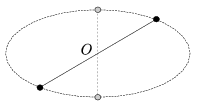 Problem P. 4254. (May 2010)
Problem P. 4254. (May 2010)
P. 4254. A group of amateur astronomers observes a newly discovered binary star. According to their observations the two stars look like a pair of bright points, whose path is the ellipse shown in the figure. Ester, the most enthusiastic member of the group, recently learned Kepler's laws in the high-school. According to her knowledge the celestial bodies really move along elliptical paths, but the attractive centre is not at the symmetry centre O of the ellipse but at one of its foci. She suspects that the two stars revolve about an invisible black hole, which has much greater mass than that of the stars, and which is at the focus of the ellipse. Can Ester be right? How would you explain the observation?

(3 pont)
Deadline expired on June 10, 2010.
Sorry, the solution is available only in Hungarian. Google translation
Megoldás. Ha az ellipszis gyújtópontjában egy fekete lyuk lenne, akkor Kepler II. törvénye miatt a két csillag helyzete az elliszis középpontjára nézve nem lehetne szimmetrikus. Valójában két egyenlő tömegű, a közös tömegközéppontjuk körül körpályán keringő csillagról van szó, a körpálya síkja azonban ,,ferdén áll'' a megfigyelés irányához képest, ezért látszik ellipszisnek.
Statistics:
22 students sent a solution. 3 points: Bolgár Dániel, Koncz Gabriella, Neumer Tamás, Szabó 928 Attila, Takács 737 Gábor. 2 points: Horicsányi Attila, Horváth Dániel, Kovács 444 Áron, Kovács Attila, Láng Hanga, Pácsonyi Imre. 1 point: 7 students. 0 point: 4 students.
Problems in Physics of KöMaL, May 2010
